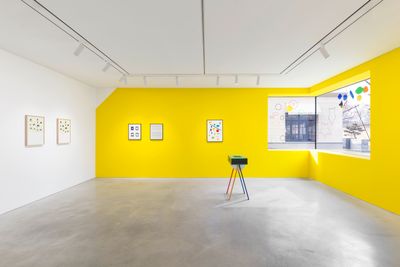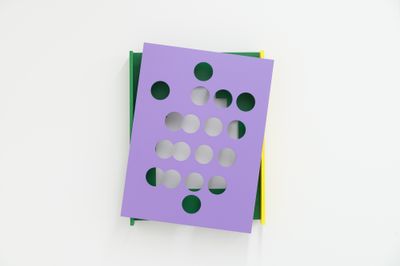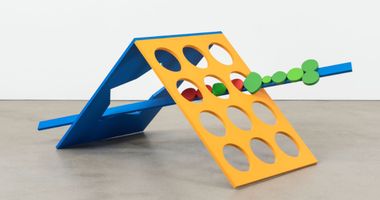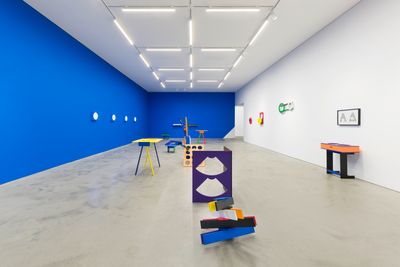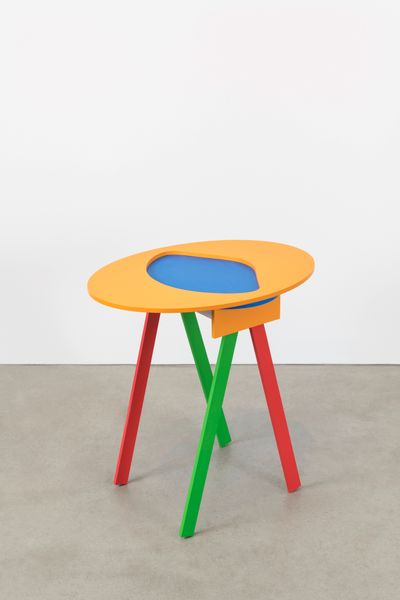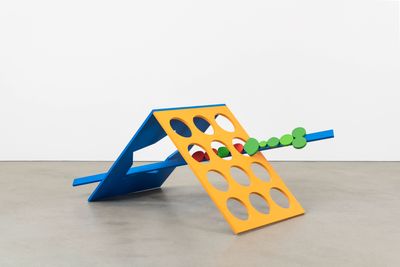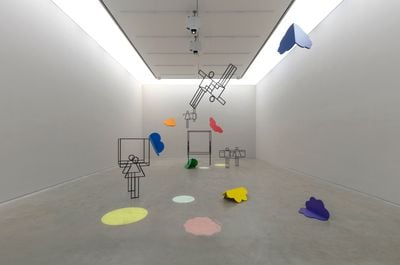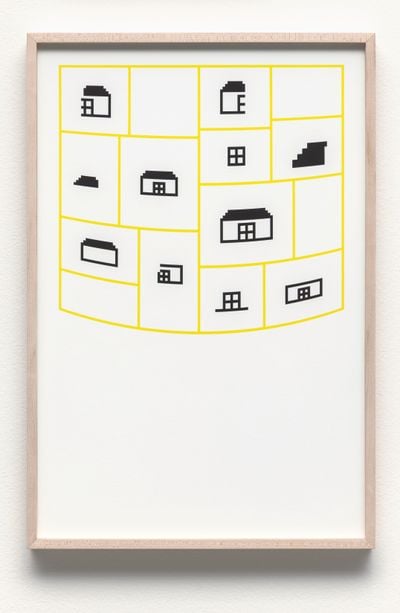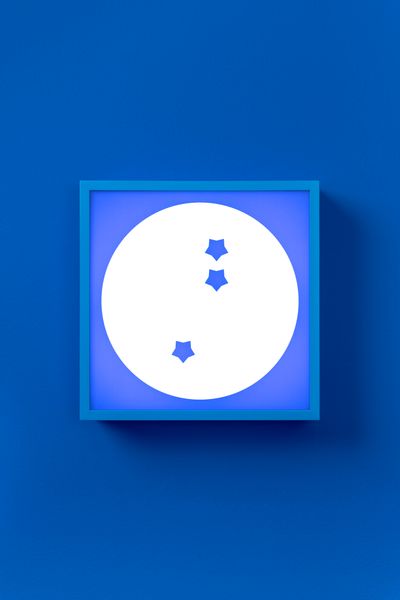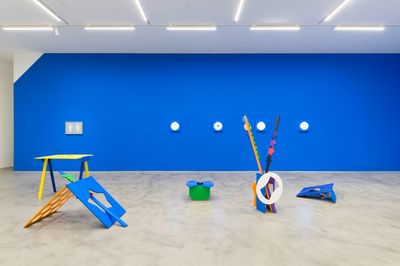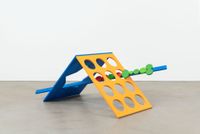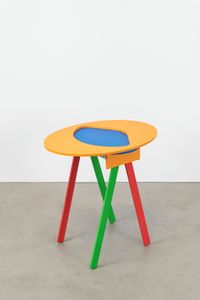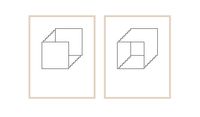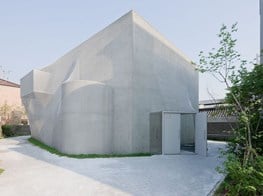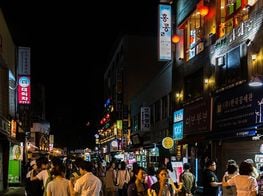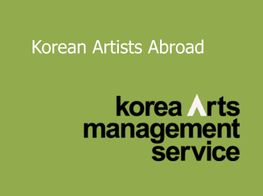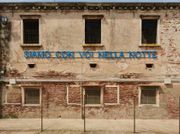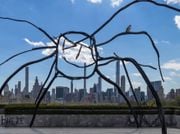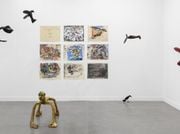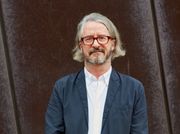Hong Seung-Hye: Ahead of the Curve
In Partnership with Korea Arts Management Service
Hong Seung-Hye. Courtesy the artist and Kukje Gallery. Photo: Chunho An.
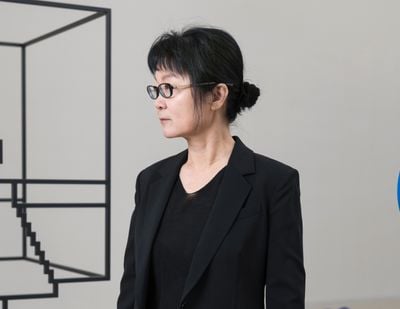
Hong Seung-Hye. Courtesy the artist and Kukje Gallery. Photo: Chunho An.
For the Korean artist Hong Seung-Hye, everyday objects and images can all be broken down into pixels, lines, or shapes.
Initially trained as a painter in Seoul and Paris in the eighties, Hong Seung-Hye moved away from the canvas and towards the digital grid in 1996 using the computer distributed to professors within her department at the Seoul National University of Science and Technology. It took her six months to turn on the computer and experiment with its features, which included drawing first with the Paint tool, and later Adobe Photoshop.
Since then, Photoshop has been Hong's primary tool, helping her to zoom in, ever-diligently, on the granularity of the pixel—the smallest measurable unit in a digital image.
Guided by sets of rules and logics, Hong has explored the tensions between dualities of planar and dimensional, optical and sensory, perception and illusion, construction and deconstruction, and positive and negative space. Her works, realised in the physical realm as sculptures, wall paintings, drawings, and installations, are surprisingly diverse, revealing the infinite possibilities for the rendering of the pixel in everyday life.
Hong's first solo show in 1997 at Kukje Gallery, Organic Geometry, featured works harvested through Photoshop's raster-based graphics. More than 20 years later, her monograph Organic Geometry (2020) adopted the same title. It is the first publication in English focusing on Hong's work.
Published by Scheidegger & Spiess, Organic Geometry features essays by art activist Hwang In, former Seoul Museum of Art director Beck Jee-sook, critic Michael Lim, and art historian Yun Nanjie, and traces Hong's career over the past two decades from her early paper collages to recent video works.
This year, Hong has participated in numerous group exhibitions including Dynamics·Variations at Spacemom Museum of Art, Cheongju (12 May–16 June 2023); Warped Mesh (15 June–15 July 2023) at Gallery SP, Seoul; and Bulgari Serpenti 75 Years of Infinite Tales (23 June–31 July 2023), hosted by Kukje Gallery in Seoul.
For Warped Mesh, Hong presented new sculptures, drawings, and mixed-media works made with materials including eco board, acrylic latex paint, and UV printing on tempered glass. The wall-based sculpture Frame Type Relief (2023) comprises layered sheets of thick, rigid eco board, each painted in a single colour and cut out with various shapes so as to reveal the layer (or wall) beneath.
For an exhibition by the Italian luxury fashion house Bulgari, Hong has on view the new commission Trop Long (2023), a sculptural installation featuring the pixelated outline of the archetypal symbol for women—most often seen at restroom entrances—alongside a wavy wooden linear form, supposedly representative of the brand's emblematic serpent.
More recently, however, Hong has been compelled to break free from the self-described 'prison of pixels'. In advance of her solo show Over the Layers II at Kukje Gallery, Seoul (9 February–19 March 2023), she learned to use Illustrator, Adobe's first software application released in 1987.
While Photoshop was developed for manipulating two-dimensional raster graphics, Illustrator is used to edit vector graphics, which, unlike pixel-based raster graphics, are composed directly from geometric shapes—points, curves, lines, or polygons—on a Cartesian plane.
To an untrained eye, this distinction may seem blurry or inconsequential. But for Hong, who has built architectural and organic images out of the pixel for more than two decades, using Illustrator means that she now has more flexibility over how she places a plane or a line.
Reflecting this newfound freedom, Over the Layers II featured multimodal rooms resembling a kindergarten interior or playroom, with cobalt blue and sunshine yellow feature walls, and the gallery's street-facing corner window adorned with simple, colourful shapes and outlines.
The gallery spaces were populated with objects and sculptures in similarly bright colours. In Console/Table (2023), a colourful circular tabletop is inset with an abstract blue form and supported with green and red trestle legs.
When Flowering (2023) adopts the form of a shape-sorter toy, with two relief planes—a blue plane with a star-shaped cutout, and a yellow plane with a three-by-four grid of circles cut out—speared by a long rod affixed with smaller green and red discs of various sizes.
Evoking learning tools for early childhood development—such as shape sorter toys, stacking blocks, or visual diagrams intended for building infants' abilities to differentiate shapes and colours and develop fine-motor skills—Hong's recent exhibitions reflect a more playful approach to pixels and geometric forms, sending viewers into a time warp of cognitive interpretation.
In this interview, Hong Seung-Hye discusses her innate desire to see the physical world broken down into geometric forms, liberated from the constraints of the grid.
MKYou have described conceptualising exhibitions in series, such as your solo exhibition at Kukje earlier this year, Over the Layers II, acting as a sequel to your first Over the Layers show in 2004. How do you see these working together?
HSHLayers are the primary environment of the computer programmes I use, as well as the accumulation of artistic elements—forms, colours, tools, texts—in the works' evolution. Over the Layers II was an opportunity to survey the addition of new layers and their chemical effects on my work today, expanding on my works in the first exhibition 20 years earlier.
MKYou have talked about wanting to be freed from the 'prison' of the pixel and learning to use Adobe Illustrator for your latest shows as part of this. How has your approach changed since using this programme, and what pathways has this led you towards?
HSHThe artistic form of stacking up pixels like bricks intrinsically cannot escape the horizontal/vertical grid. Humans tend to feel a sense of security in relevant restraint as opposed to infinite freedom. For a time, I felt secure in the 'prison' that is the grid. But naturally, when something is prolonged, you start to dream about a different dimension. Through the world of vectors, I could be freed from the grid and draw anything liberally.
MKYou have often cited the influence of Henri Matisse and his paper cut-out technique in your work. Can you expand on this? What are some of your other artistic and non-artistic influences?
HSHMatisse's unconventional act of liberating colour from design and using it as an autonomous agent was a critical influence on me during my school years and what drew me into the art world.
You could say that my work is a homage to art history. The ideas of modernists, such as Piet Mondrian—the godfather of geometric abstraction—and Kazimir Malevich, are the foundation of my work. As a child, I was infatuated with fairytale fantasies, which effected my work gravely, as well as old movies such as Victor Fleming's The Wizard of Oz (1939), and Charles Chaplin's comedies full of pathos, like Modern Times (1936).
MKCan you talk about the resemblance of some of your recent sculptures and multimedia works to children's furniture and children's toys?
HSHI have an artistic desire to simplify all physical and metaphysical things of the world in a geometric and graphic manner. This might have to do with the economics of forms—arithmetic-based computer programmes are therefore a very fitting tool for me. Sculptures, videos, and everyday practical objects such as furniture and toys all share this same formative language. These basic forms become a helpful starting point for planning and handling real spaces.
MKWhat is next for you in your practice?
HSHMaking 'real' spaces might be the ultimate goal of my practice—I want to continue to pursue architectural interventions. The objects that I create exist as artworks in themselves, as well as elements that make up a certain place. I am also interested in making a Gesamtkunstwerk stage inclusive of stereoscopic images, sound, and even performance. —[O]



